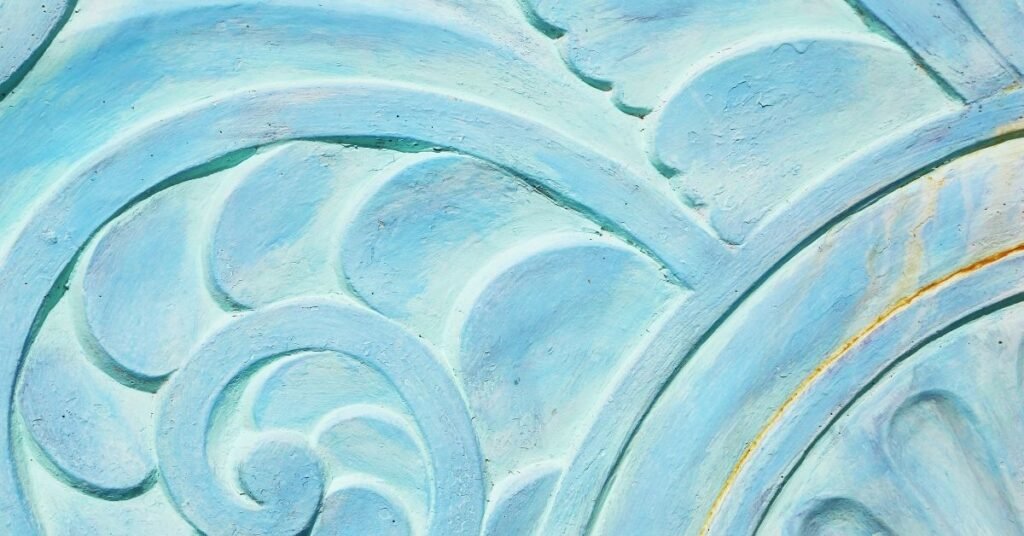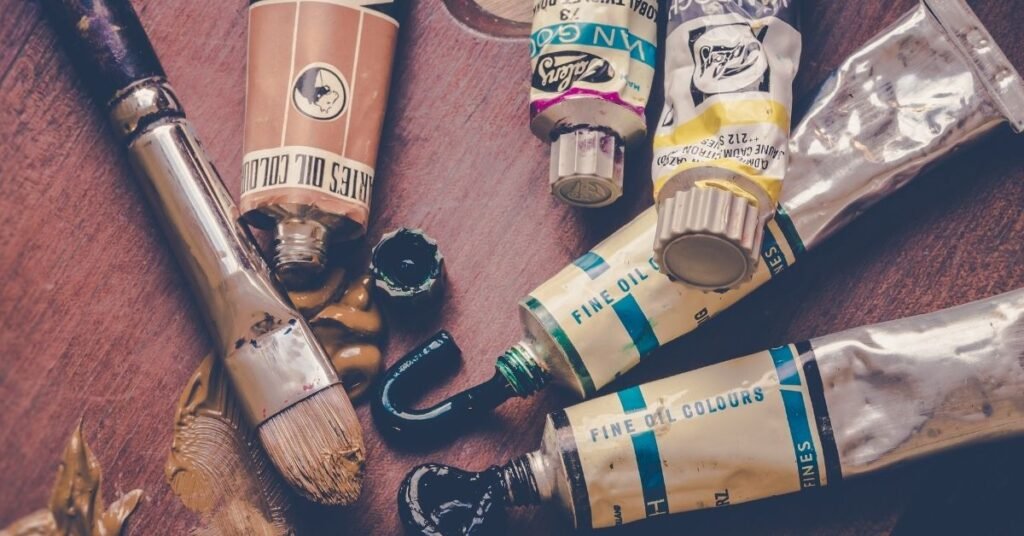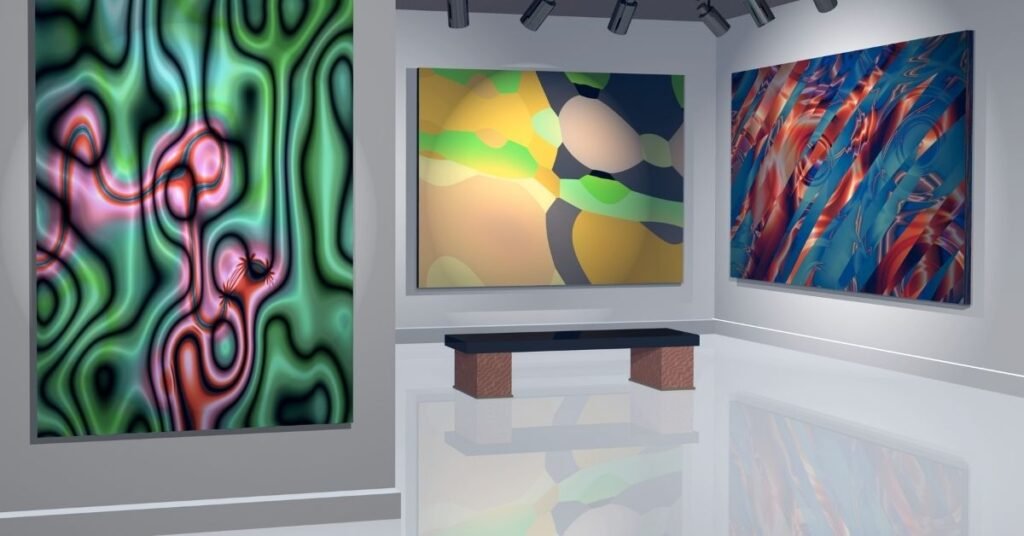We get a lot of questions about art terminology. Here is a glossary of art terms with definitions and pronunciation where needed.
Abstract Expressionism – Abstract style originating in the United States in the 1940’s emphasizing spontaneity and energy.
Acrylic – A plastic used as a medium for pigments in painting or as a casting material in sculpture. Plexiglas and Lucite are clear acrylics. A synthetic based paint. Acrylic is fast drying and glossy when dried.
Appliqué – French meaning “applied” and pronounced “ap-li-kay”. A cutout attached to a background.
Aquarelle – (pronounced “ak-we-rell”) A transparent watercolour.
Aquatint – a process in which spaces rather than lines are acid-etched onto a metal plate. Prints pulled from an aquatint plate show a tonal effect similar to a wash drawing or a watercolour.
Art Deco – Style in decoration and architecture, originating in the 1920’s characterized by streamlined, rhythmic patterns.

Art Nouveau – Ornamental style from the 1890’s, influential in design, employing sinuous lines and simplified forms.
Artist Proof – (abbreviation: A.P.) A print outside of the numbered series, usually one tenth the edition. Hand signed or approved by the artist for quality control and colour correctness. Most often sought after by collectors. May or may not be a numbered series.
Artist Signed Stamp – A stamp signed by the artist and framed in combination with a stamp print.
Assemblage – Sculpture formed by joining individual pieces, sometimes “found objects”.
Bas-Relief – (French meaning “low relief’ and pronounced “Bah relief’) Sculpture in which figure projects only slightly from background.
Batik – A fabric dyeing process that uses wax as a resist. Working from light to dark, more and more areas of colour are preserved in wax until the final dark-dye is applied. When the image is done, wax is removed to show gradients of colour.
Bon-a-Tirer – (French meaning “good to pull”) Pronounced “bone-ah-ti-ray”. The first impression of a print run acceptable to the artist and used as the standard with which each subsequent impression is compared.
Canvas Edition – A lithograph printed on canvas or giclee on canvas. (see Giclee)
Catalogue Raisonne – (French meaning ” raised catalogue” and pronounced “catalog re-zo-Nay”) Complete descriptive listing of an artist’s work.
Certificate of Authenticity – Certificates that identify the authenticity of the limited edition print or canvas print.
Clayboard – Archival particle board, coated with acid-free porcelain onto which a giclee or serigraph is printed.
Coated Paper – Paper manufactured with a thin surface coating of clay. This coating produces a sharp, finely detailed image because it prevents ink from absorbing into the fibers.
Collage – (pronounced “co-LAZH”) a work made by gluing pieces of paper, fabric, etc. onto a flat surface.
Commission Print – Also called ” time-limited edition” print, or “subscription edition”. The edition size is determined by the number of orders received as of an established deadline date.
Commission – To order an original work from an artist.
Computer Art – Images electronically produced and generated by a computer.
Condition – A print’s physical condition influences its market value. Condition typically is described as ranging from “mint”- completely undamaged and original, to “poor”. A poor condition print may be creased, torn, water or tape blemished, trimmed smaller than its original size, or otherwise damaged.
Conservation Framing – Methods of mounting and framing that preserve a print in original mint condition. Usually any framing processes whose materials come in contact with the print are acid free.
Charcoal – A drawing medium (pencil or crayon) made from a porous carbonaceous material.
Chromolithography – A colour-printing process in which separate printing plates are used to apply each component colour. Often called “four colour” printing because the full range of colour tones are achieved with only four plates- red, blue, yellow, and black.
Cubism – Style inaugurated by Picasso and Braque in the early 20th century featuring fragmentation and rearrangement of natural forms.
Dadaism – Movement originating during and after World War One emphasizing the incongruous and accidental while mocking the traditions of art.
Diptych – A two-part painting often of attached panels.
Dry Mount – Framing method in which a print is fastened to a stiff backing with non-liquid adhesive. Dry—mounting is not recommended for prints of any value.
Dry Point – An intaglio technique like engraving in which the image is drawn on a metal plate with a needle, raising a ridge which prints a soft line.
Edition – The authorized number of impressions made from a single image, including all numbered prints and proofs; a limited edition has a specified number noted on the impression. Edition size: number of prints in the edition.
Egg Tempera – This painting medium combines pigment with egg yolk and distilled water.
Embossed Print – Un-inked relief print in which dampened paper is pressed into recessed areas of a plate to produce a three-dimensional impression.
Encaustic – style of painting using pigments mixed with hot wax, which are burned- in as an inlay.
Engraving – An intaglio process in which lines are cut into a metal plate and then filled with ink to transfer the image onto paper.
Etching – An intaglio process in which an image is scratched through an acid resistant coating on a metal plate. The plate is then dipped in acid, which eats into the exposed surface. Prints are then made from the etched surface.
Fauvism – ( French meaning ” wild beast” and pronounced “FOHV-ism”) An early 20th century French style employing thick outlines and bold, often clashing colours unrelated to the subjects in nature.
Foreshortening – Alteration of scale of an image to suggest perspective.
Found Object – A natural object incorporated in a work of art, such as a leaf, feather, etc.
Giclée – A fine art printing process meaning fine spray, which is the medium created with the help of a computer controlled mist distribution printer.
Gouache – (pronounced ” gwash ) Watercolour to which an opaque white has been added.
Graphic – Any work printed from a plate or block.
Ground – The surface upon which a painting is done- canvas, Masonite, and so on. Haute Relief- (French for “high relief” and pronounced “0 relief”) High sculpture relief in which figures project from a background at least half of their depth.
Hors De Commerce – French meaning “outside of sale” and pronounced “Or de com-airce.” A designation for prints not in the numbered series pulled for the use of the publisher, normally limited to 5 or 6.
Image Size – Actual dimensions of a printed image, referring only to the image itself and not to the size of the paper it is printed upon.
Impasto – Thick applications of paint creating a textured surface_
Impressionism – Loose spontaneous style developed in the late 19th century in France, in which artists tried to capture their impressions of light and shade.
Intaglio – (Italian meaning “incision” and pronounced “in-tahl-yo”) Any technique in which an image is incised below the surface of the plate, including dry point, etching, aquatint, engraving and mezzotint.
Issue Price – The original price of a limited edition print when first offered for retail sale.
Limited Edition – The practice of limiting the number of prints made of an image by canceling or destroying the printing materials used to create it.
Linocut – A process in which an image is cut in relief on a linoleum block.
Lithography – A planographic process in which images are drawn with crayons or greasy ink on a stone or metal and then transferred to paper.
Margin – The white, unprinted area surrounding a printed image.
Matrix – A printing surface on which an image is drawn or incised. The matrix may be made of wood, stone, metal, plastic, linoleum, or any other substance that will print images on paper.
Medallion – Cast metal medallions sometimes are issued in conjunction with the publication of prints, especially stamp prints. Design of the medallion artwork usually duplicates some portion of the print.
Medium – (plural: media) the material or technique used in creating a work of art. Oil paint, acrylic paint, watercolour, bronze, wood, and stone are all examples of artistic media.
Mezzotint – An intaglio process in which the plate surface is roughened and then an image is created by smoothing the areas to be printed.
Minimalism – Style emerging in the mid 20th century in which the elements are the simplest possible forms.
Mint Stamp – An unsigned stamp framed with a copy of the print from which the stamp was made.
Mixed Media – The use of different materials in the same work.
Mobile – A sculpture that permits motion.
Monotype – A unique print made from an inked, painted glass or metal plate.
Numbered – Each copy of a limited edition print is marked with two numbers, separated by a slash mark. The first number identifies the particular copy, and the second indicates edition size. 35/950, for instance identifies print number 35 of a 950-copy edition.
Offset Lithography – The modern and mechanized process called “offset Lithography” the image to be printed is photographically applied to a metal plate that is then mounted onto the roller of a printing press. Ink is applied to the plate. Transferred to a rubber roller called a “blanket” onto paper. Offset lithography is today the most widely used method of printing.

Oil – Paint made of pigment mixed with oil, usually linseed. The oil serves to keep the paint fluid for a period of time and then as a drying and hardening agent.
Op Art – Name coined in the 1970’s for a style popular in 1947 employing optical illusion by juxtaposing colour and line in geometric patterns that seem to vibrate.
Open Edition – A print produced with no predetermined limit to the number of copies that might be made. Open edition prints may or may not be signed by the artist.
Original Art is any work considered to be an authentic example of the works of an artist, rather than a reproduction or imitation. That original may be a painting of some kind, or a sculpture, or a performance work, or one of many other kinds of media.
Original Print – An image created in multiples that is conceived by the artist as a print (it is not a copy of a pre-existing work originally created in some other art medium) and drawn by the artist on a matrix or printing surface. The matrix is then used to print the image on sheets of paper. This task may be performed directly by the artist or by a craftsmen working under the artist’s supervision.
Overall Print Size – The physical dimensions of the paper upon which a print is made.
Pastel – A soft chalk made of pigments, water and a binder, which is blended into a stiff paste and dried.
Pencil – A drawing implement made of graphite, crayon, or a similar substance enclosed in wood or a hand-held mechanism made of plastic or metal.
Picture Frame – a protective and decorative edging for a picture, such as a painting or photograph. It makes displaying the work safer and easier and both sets the picture apart from its surroundings and aesthetically integrates it with them.
Planography – Any process of printing from a surface level with the plate, as in lithography.
Pointillism – Late 19th century French style using small dots of pure colour to produce images.
Pop Art – American style of the 1960’s employing imagery from popular and commercial culture to satirize or give emblematic value to familiar objects.
Proof – A publisher’s sample of a future limited edition release. Not for sale. Usually has the word ” PROOF” or “SAMPLE” stamped on or in the image.
Publisher – A company whose business is to produce and market prints.
Rag Paper – Paper used for prints, which contains a certain proportion of cotton fiber in its physical structure. The higher the cotton content, the higher the quality of paper.
Relief – A technique in which the portions of a plate intended to print are raised above the surface, as in woodcut, linocut, etc.
Remarque – A small original drawing or sketch made by an artist in the margin of a print. An artist personalization.
Roman Numbered Edition – A smaller edition numbered with Roman numerals, usually a deluxe edition on higher quality paper.
Rigiclée – A giclée process on archival porcelain coated Masonite board for supreme longevity.
Scratchboard – Cardboard coated with chalk forms a smooth, glossy surface, which is used as a ground for drawing or painting in ink. Parts of the image may then be scratched off with a pointed tool to create a variety of effects.
Secondary Market Value – The value of a print, determined by supply and demand, after all copies have been sold out at original issue price.
Serigraphy – (Screen printing or silk screen) A stencilling method in which the image is transferred to paper by forcing ink through a fine mesh in which the background has been blocked.
Signature – The artist’s signature, applied to the original work, as it appears in a print or, more frequently, the artist’s signature in pencil, on each copy of a print.
Signed and Numbered – A print bearing an original signature and copy/edition number.
Signed Only – A print signed by the artist but not numbered. (See open edition)
Signed in the Plate – Refers to the artist’s signature on an original work, as it appears in a print.
Sold Out – Said of a limited edition print once it is no longer available at issue price and is being sold instead at secondary market prices.

Stamp Print – Limited edition print made from a work originally created as the design for a conservation group. Print and stamp customarily are framed together.
State – (first, second, etc.) Version of a print which has been altered in colour or image as the edition is printed.
Subscription Edition – A size of edition determined by the number of orders received before a predetermined deadline.
Surrealism – Style using imagery from dreams and the subconscious, often distorting forms of ordinary objects or placing them in new contexts.
Tempera – Pigments mixed with a water-soluble base such as casein, size, or egg yolk. Tempera dries with a flat, dull finish.
Tetraptych – (pronounced “te-TRAP-tick”) A four part painting.
Triptych – (pronounced “trip-tick”) A three-part painting. Three panels.
Trompe L’ oeil – French meaning “fool the eye” and pronounced “trom-LOY” Style in painting so naturalistic that the eye is deceived into flat surfaces as three dimensional.
Watercolour – Pigments dissolved in water. Watercolour painting typically is done on relatively rough-surfaced, absorbent paper.
Woodcut – A process in which the image is cut in a relief on a wood block.
Let us know if we’ve missed any art terminology!